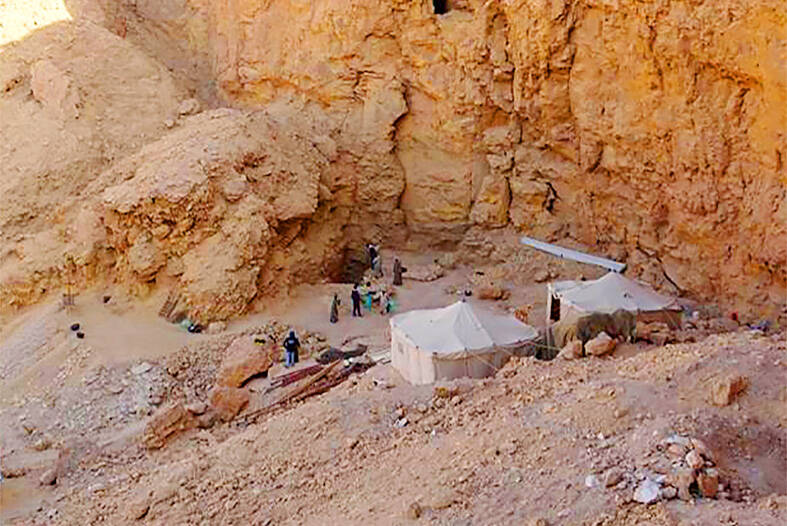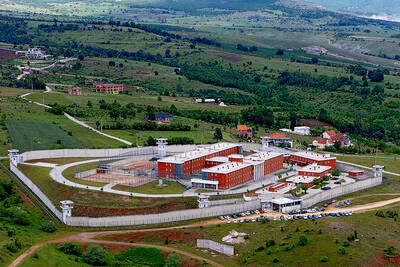Egyptian authorities on Saturday announced the discovery of an ancient tomb in Luxor dating back about 3,500 years that archeologists believe holds the remains of a royal of ancient Egypt’s New Kingdom era.
The tomb was unearthed by Egyptian and British researchers on the west bank of the River Nile, where the famous Valley of the Queens and Valley of the Kings lie, Egyptian Supreme Council of Antiquities Secretary-General Mostafa Waziri said.
“The first elements discovered so far inside the tomb seem to indicate that it dates back to the 18th dynasty” of pharaohs Akhenaton and Tutankhamun, Waziri said in a statement.

Photo: AFP / HO / EGYPTIAN MINISTRY OF ANTIQUITIES
The 18th dynasty ended in 1292 BC and is considered one of the most prosperous times in ancient Egypt.
University of Cambridge professor Piers Litherland, head of the British research mission, said the tomb could be of a royal wife or princess of Thutmosid lineage.
Egyptian archeologist Mohsen Kamel said the tomb’s interior was “in poor condition.”
Parts of it including inscriptions were “destroyed in ancient floods which filled the burial chambers with sand and limestone sediment,” the antiquities agency’s statement cited Kamel as saying.
Egypt has unveiled several major archeological discoveries in the past few years, most notably in the Saqqara necropolis south of Cairo.
Critics say the flurry of excavations has prioritized finds shown to grab media attention over hard academic research.
The discoveries have been a key component of Egypt’s attempts to revive its tourism industry, the crowning jewel of which is the long-delayed inauguration of the Grand Egyptian Museum near Cairo.
The country of 104 million inhabitants is in a severe economic crisis.
Egypt’s tourism industry accounts for 10 percent of GDP and about 2 million jobs, official figures show.
It has been hammered by political unrest and the COVID-19 pandemic.

Packed crowds in India celebrating their cricket team’s victory ended in a deadly stampede on Wednesday, with 11 mainly young fans crushed to death, the local state’s chief minister said. Joyous cricket fans had come out to celebrate and welcome home their heroes, Royal Challengers Bengaluru, after they beat Punjab Kings in a roller-coaster Indian Premier League (IPL) cricket final on Tuesday night. However, the euphoria of the vast crowds in the southern tech city of Bengaluru ended in disaster, with Indian Prime Minister Narendra calling it “absolutely heartrending.” Karnataka Chief Minister Siddaramaiah said most of the deceased are young, with 11 dead

By 2027, Denmark would relocate its foreign convicts to a prison in Kosovo under a 200-million-euro (US$228.6 million) agreement that has raised concerns among non-governmental organizations (NGOs) and residents, but which could serve as a model for the rest of the EU. The agreement, reached in 2022 and ratified by Kosovar lawmakers last year, provides for the reception of up to 300 foreign prisoners sentenced in Denmark. They must not have been convicted of terrorism or war crimes, or have a mental condition or terminal disease. Once their sentence is completed in Kosovan, they would be deported to their home country. In

Brazil, the world’s largest Roman Catholic country, saw its Catholic population decline further in 2022, while evangelical Christians and those with no religion continued to rise, census data released on Friday by the Brazilian Institute of Geography and Statistics (IBGE) showed. The census indicated that Brazil had 100.2 million Roman Catholics in 2022, accounting for 56.7 percent of the population, down from 65.1 percent or 105.4 million recorded in the 2010 census. Meanwhile, the share of evangelical Christians rose to 26.9 percent last year, up from 21.6 percent in 2010, adding 12 million followers to reach 47.4 million — the highest figure

LOST CONTACT: The mission carried payloads from Japan, the US and Taiwan’s National Central University, including a deep space radiation probe, ispace said Japanese company ispace said its uncrewed moon lander likely crashed onto the moon’s surface during its lunar touchdown attempt yesterday, marking another failure two years after its unsuccessful inaugural mission. Tokyo-based ispace had hoped to join US firms Intuitive Machines and Firefly Aerospace as companies that have accomplished commercial landings amid a global race for the moon, which includes state-run missions from China and India. A successful mission would have made ispace the first company outside the US to achieve a moon landing. Resilience, ispace’s second lunar lander, could not decelerate fast enough as it approached the moon, and the company has